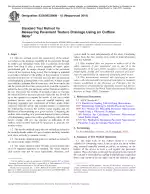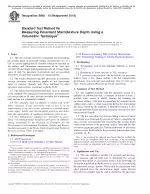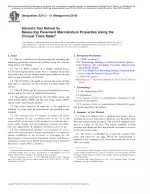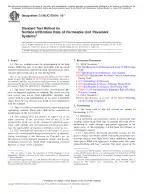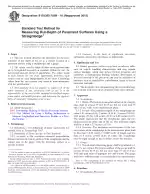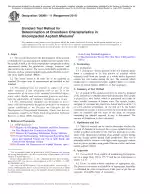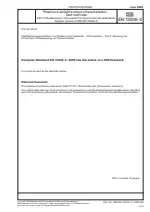ASTM E2380/E2380M-15 (R2019) PDF Download
Standard ENStandard Test Method for Measuring Pavement Texture Drainage Using an Outflow Meter
Also Known As:
ASTM E2380/E2380M-15 (R2019) is a standard test method that is used to measure the pavement texture drainage using an outflow meter. This test method provides a field test to evaluate the surface drainage and, in some cases, the internal drainage of the surface course of a pavement. It can be used to evaluate the texture produced by different asphalt concrete mixes, finishing methods used on portland cement concrete pavement, and refinishing operations on existing pavement surfaces. The outflow time measured by this method can be correlated with other methods such as the CT Meter, MPD, and MTD.
It is important to note that the outflow time is an indication only and does not provide a complete assessment of pavement surface friction or wet weather safety characteristics. Additionally, this test method may not necessarily correlate or agree with other methods of measuring pavement surface characteristics, and it is up to the operator to determine the correlation of each method considered.
The purpose of this test method is to measure the connectivity of the pavement texture in relation to its drainage capability. By timing how long it takes a known quantity of water, under gravitational pull, to escape through voids in the pavement texture, the test provides an indication of the pavement's ability to relieve pressure from vehicular tires and the potential for hydroplaning under wet conditions. A shorter outflow time indicates a thinner film of water between the tire and the pavement, potentially leading to improved surface friction and lower water pressure under the tire.
To determine the relationship between the outflow meter reading and the likelihood of hydroplaning on a given surface, the operator must consider various factors such as expected rainfall intensity and frequency, aggregate type, texture consistency, grade, slope, expected vehicular speed, and accident history. By comparing the test results of pavements with a history of hydroplaning against those with good histories, the operator can determine the outflow meter reading needed to promote wet weather safety.
The results obtained from this test method are related to the mean hydraulic radius of the pavement surface and may also correlate with other methods used to measure pavement texture and mean texture depth (MTD).
| Descriptors | hydroplaning, pavement texture, tire-pavement contact pressure, surface drainage, pavements, outflow meters,Fluid Flow Meters,ForceCOMMA Pressure,Physical Properties,Plumbing and Sewers,Roads and Pavements,Surface Properties |
| ICS Codes | 93.080.10 - Road construction |
| Language(s) | English |
| File Size | 133.1 KB |

